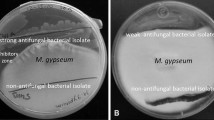Abstract
Azadiracchta indica A. Juss. (Neem) is a perennial tree belonging to Meliaceae family. Neem has special importance in various traditional systems of medicine in India and is known to be the “Panacea for all diseases.” All parts of the neem tree—leaves, flowers, seeds, fruits, roots and bark—have been used traditionally for the treatment of inflammation, infections, fever, skin diseases and dental disorders. The current chapter deals with the application of neem products in treatment of skin diseases. Skin diseases are normally the results of infection due to bacteria, viruses, or fungi. Scientific research has proved the antifungal, antiviral, antibacterial and, hence, antidermatophytic effects of different parts of the plant. Neem compounds have proven their potential in treatment of athlete’s foot, ringworm and candida infections. Recent studies revealed the antidermatophytic effects of neem compounds against various fungal genera—Microsporum, Trichophyton and Epidermophyton that commonly cause skin disease. Sarcoptes scabiei var. hominis mites were collected from skin scrapings obtained from seven crusted scabies patients over a period of 2 years. Larvae, nymphal instars and adult mites were tested within 3 h of collection and continuously exposed to selected commercially available treatment products until death, with the elapsed time recorded.
Access this chapter
Tax calculation will be finalised at checkout
Purchases are for personal use only
Similar content being viewed by others
Abbreviations
- MFC:
-
Minimum fungicidal concentration
- MIC:
-
Minimum inhibitory concentration
- SD:
-
Sabouraud dextrose
References
Biswas K, Chattopadhyay I, Banerjee RK, Bandopadhyay U. Biological activities and medicinal properties of neem (Azadirachta indica). Curr Sci. 2002;82(11):1336–45.
Khare CP. Indian medicinal plants an illustrated dictionary with 215 pictures of crude herbs. Berlin/Heidelberg: Springer; 2007. p. 75–6.
Joy PP, Thomas J, Mathew S, Skaria BP. Medicinal plants. Kerala, India: Kerala Agriculture University, Aromatic and Medicinal Plant Research Station; 1998. p. 56–7.
Anonymous. The Ayurvedic Pharmacopoeia of India Part-I (formulations) Volume-2. 1st ed. New Delhi: Government of India, Ministry of Health and Family Welfare, Department of Ayurveda, Yoga & Naturopathy, Unani, Siddha and Homoeopathy. p. 94–6, 144–9, 160–2.
Natrajan V, Venugopal PV, Menon T. Effect of Azadirachta indica (neem) on the growth pattern of dermatophytes. Indian J Med Microbiol. 2003;21(2):98–101.
Niharika A, Aquicio JM, Anand A. Antifungal properties of neem (Azadirachta indica) leaves extract to treat hair dandruff. Int Sci Res J. 2010;2(3):244–52.
Charles V, Charles SX. The use and efficacy of Azadirachta indica ADR (neem) and Curcuma longa (turmeric) in scabies. A pilot study. Trop Geogr Med. 1992;44(1–2):178–81.
Abdel-Ghaffar F, Semmler M. Efficacy of neem seed extract shampoo on head lice of naturally infected humans in Egypt. Parasitol Res. 2007;100(2):329–32.
Srivastava A, Nagpal BN, Saxena R, Subbarao SK. Predictive habitat modelling for forest malaria vector species An. Dirus in India—a GIS based approach. Curr Sci. 2001;80(9):1129.
Barceloux D. Medical toxicology of natural substances. Hoboken, NJ: Wiley; 2008. p. 5–8.
Author information
Authors and Affiliations
Corresponding author
Editor information
Editors and Affiliations
Rights and permissions
Copyright information
© 2013 Springer Science+Business Media New York
About this chapter
Cite this chapter
Pimple, B.P., Badole, S.L., Menaa, F. (2013). Exploring Neem (Azadirachta indica) for Antidermatophytic Activity. In: Watson, R., Zibadi, S. (eds) Bioactive Dietary Factors and Plant Extracts in Dermatology. Nutrition and Health. Humana Press, Totowa, NJ. https://doi.org/10.1007/978-1-62703-167-7_43
Download citation
DOI: https://doi.org/10.1007/978-1-62703-167-7_43
Published:
Publisher Name: Humana Press, Totowa, NJ
Print ISBN: 978-1-62703-166-0
Online ISBN: 978-1-62703-167-7
eBook Packages: MedicineMedicine (R0)




